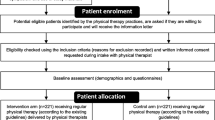Abstract
Introduction Stakeholder cooperation in return to work has been increasingly emphasised in research, while studies on how such cooperation works in practise are scarce. This article investigates the relationship between professionals in Swedish interdisciplinary rehabilitation teams, and the aim of the article is to determine the participants’ definitions and uses of the concept of work ability. Methods The methods chosen were individual interviews with primary health care centre managers and focus groups with twelve interdisciplinary teams including social insurance officers, physicians, physiotherapists, occupational therapists, medical social workers and coordinators. Results The results show that the teams have had problems with reaching a common understanding of their task, due to an inherent tension between the stakeholders. This tension is primarily a result of two factors: divergent perspectives on work ability between the health professionals and the Social Insurance Agency, and different approaches to cooperative work among physicians. Health professionals share a holistic view on work ability, relating it to a variety of factors. Social insurance officers, on the other hand, represent a reductionistic stance, where work ability is reduced to medical status. Assessments of work ability therefore tend to become a negotiation between insurance officers and physicians. Conclusions A suggestion from the study is that the teams, with proper education, could be used as an arena for planning and coordinating return-to-work, which would strengthen their potential in managing the prevention of work disability.

Similar content being viewed by others
References
Brunarski D, Shaw L, Doupe L. Moving toward virtual interdisciplinary teams and a multi-stakeholder approach in community-based return-to-work care. Work (Reading, Mass). 2008;30(3):329–36.
Franche R-L, Baril R, Shaw W, Nicholas M, Loisel P. Workplace-Based Return-to-Work Interventions: optimizing the Role of Stakeholders in Implementation and Research. J Occup Rehabil. 2005;15(4):525–42. doi:10.1007/s10926-005-8032-1.
Loisel P, Durand M-J, Berthelette D, Vézina N, Baril R, Gagnon D, et al. Disability Prevention: new Paradigm for the Managemeng of Occupational Back Pain. Dis Manag Health Out. 2001;9(7):351–60. doi:10.2165/00115677-200109070-00001.
Esping-Andersen G. Why we need a New Welfare State. Oxford: Oxford University Press; 2002.
Wilthagen T, Tros F. The concept of ‘flexicurity’: a new approach to regulating employment and labour markets. Transfer: European Review of labour and research. 2004;10(2):166–86.
McCallin A. Interdisciplinary practice–a matter of teamwork: an integrated literature review. J Clin Nursing. 2001;10:419–28. doi:10.1046/j.1365-2702.2001.00495.x.
Johansson G, Lundberg I. Adjustment latitude and attendance requirements as determinants of sickness absence or attendance. Empirical tests of the illness flexibility model. Soc Sci Med. 2004;58(10):1857–68. doi:10.1016/S0277-9536(03)00407-6.
World Health Organization. International classification of functioning, disability and health. Geneva: World Health Organization; 2001.
Slebus FG, Sluiter JK, Kuijer PPFM, Willems JHHBM, Frings-Dresen MHW. Work-ability evaluation: a piece of cake or a hard nut to crack? Disabil Rehabil. 2007;29(16):1295–300. doi:10.1080/09638280600976111.
Sjukförsäkring.Kulturer och Attityder: Fyra aktörers perspektiv (Sickness Insurance, Cultures and Attitudes: Four Actors’ Perspectives) Stockholm: Försäkringskassan (SSIA); 2006.
Alexanderson K, Brommels M, Ekenvall L, Karlsryd E, Löfgren A, Sundberg L, et al. Problem inom hälso- och sjukvården kring handläggning av patienters sjukskrivning (Problems in health care in handling patients’ sicklisting). Stockholm: Karolinska Institutet; 2005.
de Rijk A, van Raak A, van der Made J. A New Theoretical Model for Cooperation in Public Health Settings: the RDIC Model. Qual Health Res. 2007;17(8):1103–16. doi:10.1177/1049732307308236.
Patton MQ. Qualitative research and evaluation methods. 3 ed. London: Sage; 2002.
Krueger RA. Focus groups: A Practical Guide for Applied Research. 2 ed. London: Sage; 1994.
Wibeck V. Fokusgrupper (Focus groups). Lund: Studentlitteratur; 2000.
McCallin AM. Interprofessional practice: learning how to collaborate. Contemp Nurse. 2005;20(1):28–37.
Shaw A, Lusignan S, Rowlands G. Do primary care professionals work as a team: a qualitative study. J Interprof Care. 2005;19(4):396–405. doi:10.1080/13561820500053454.
Catto SG. Professionalism pompous, pretentious and outmoded? J Interprof Care. 2005;19(4):313–4. doi:10.1080/13561820500215061.
Berwick DM. Ideas for medical education. Acad Med. 1996;71(9):972.
Berg M, Horstman K, Plass S, Heusden Mv. Guidelines, professionals and the production of objectivity: standardisation and the professionalism of insurance medicine. Sociol Health Ill. 2000;22(6):765–91. doi:10.1111/1467-9566.00230.
Wilmot S. Professional values and interprofessional dialogue. J Interprof Care. 1995;9(3):257–66. doi:10.3109/13561829509072156.
Loisel P, Falardeau M, Baril R, José-Durand M, Langley A, Sauvé S, et al. The values underlying team decision-making in work rehabilitation for musculoskeletal disorders. Disabil Rehabil. 2005;27(10):561–9. doi:10.1080/09638280400018502.
Storheim K, Brox JI, Holm I, Bø K. Predictors of return to work in patients sick listed for sub-acute low back pain: a 12-month follow-up study. J Rehabil Med. 2005;37(6):365–71. doi:10.1080/16501970510040344.
Lincoln Y, Guba E. Naturalistic inquiry. Newbury Park: Sage; 1985.
Acknowledgments
The authors wish to thank Linda Schultz for assisting with the data collection, Peter Johansson and Grace Hagberg for help with the selection of participants, Lars-Christer Hydén for comments on the design, and Åsa Tjulin for valuable support during the revision of the text.
Competing interests
The authors declare that they have no competing interests.
Authors’ contributions
CS: study design, fieldwork, first draughts of the analysis and writing the text. KE: study design, examining and commenting on the analysis and the manuscript. TS and GP: examining and commenting on the analysis and the manuscript.
Author information
Authors and Affiliations
Corresponding author
Rights and permissions
About this article
Cite this article
Ståhl, C., Svensson, T., Petersson, G. et al. The Work Ability Divide: Holistic and Reductionistic Approaches in Swedish Interdisciplinary Rehabilitation Teams. J Occup Rehabil 19, 264–273 (2009). https://doi.org/10.1007/s10926-009-9183-2
Received:
Accepted:
Published:
Issue Date:
DOI: https://doi.org/10.1007/s10926-009-9183-2




